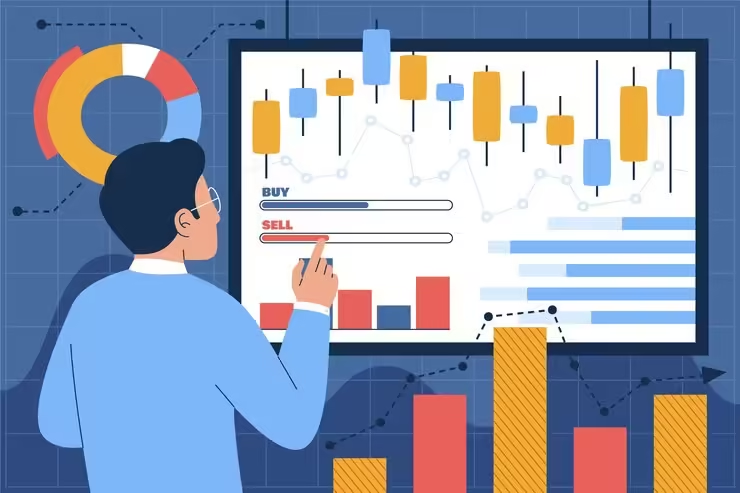Stock market trading is a fascinating world where fortunes can be made or lost in the blink of an eye. For many, it represents the ultimate challenge—a test of one’s ability to predict market movements, manage risks, and make profitable decisions under pressure. This comprehensive guide aims to introduce you to the basics of the stock market, key terms and concepts, and provide a detailed roadmap on how to get started with stock market trading.
Table of Contents
- Basics of the Stock Market
- What is the Stock Market?
- History and Evolution
- Structure and Functioning
- Key Terms and Concepts
- Types of Securities
- Market Participants
- Trading Mechanisms
- How to Get Started
- Setting Up Your Trading Account
- Developing a Trading Plan
- Essential Tools and Resources
1. Basics of the Stock Market
What is the Stock Market?
The stock market is a collection of markets where stocks (pieces of ownership in businesses) are bought and sold. It serves as a platform for companies to raise capital by issuing shares to the public and allows investors to buy and sell these shares.
Key Functions of the Stock Market:
- Capital Formation: Companies raise funds for expansion and operations.
- Wealth Creation: Investors can generate returns through dividends and capital gains.
- Liquidity: Provides a mechanism for investors to buy and sell securities easily.
- Price Discovery: Determines the price of securities through supply and demand dynamics.
- Risk Distribution: Allows for the spread of financial risk among a wide range of investors.
History and Evolution
The stock market has a rich history that dates back to the 17th century. The Amsterdam Stock Exchange, established in 1602 by the Dutch East India Company, is often considered the world’s first official stock exchange.
- 17th Century: The rise of joint-stock companies in Europe.
- 18th Century: The establishment of the London Stock Exchange.
- 19th Century: The formation of the New York Stock Exchange (NYSE).
- 20th Century: Global expansion and technological advancements.
- 21st Century: The emergence of electronic trading platforms and high-frequency trading.
Structure and Functioning
The stock market comprises several key components that work together to facilitate trading:
- Primary Market: Where new securities are issued and sold to investors.
- Secondary Market: Where existing securities are traded among investors.
- Stock Exchanges: Platforms like the NSE, BSE, NYSE, NASDAQ, and others where trading occurs.
- Regulatory Bodies: Organizations like the Securities and Exchange Board of India (SEBI) and the Securities and Exchange Commission (SEC) that oversee market activities.

2. Key Terms and Concepts
Understanding the jargon is crucial for navigating the stock market. Here are some fundamental terms and concepts:
Types of Securities
- Stocks: Shares representing ownership in a company.
- Bonds: Debt securities issued by corporations or governments.
- Mutual Funds: Investment vehicles pooling money from many investors to buy a diversified portfolio of securities.
- Exchange-Traded Funds (ETFs): Similar to mutual funds but traded on stock exchanges like individual stocks.
- Options: Contracts granting the right to buy or sell a security at a predetermined price.
Market Participants
- Retail Investors: Individual investors who buy and sell securities for personal accounts.
- Institutional Investors: Organizations like pension funds, mutual funds, and insurance companies.
- Market Makers: Firms that provide liquidity by buying and selling securities at quoted prices.
- Broker-Dealers: Firms that execute buy and sell orders on behalf of clients.
- Regulators: Bodies like SEBI that enforce market rules and protect investors.
Trading Mechanisms
- Market Orders: Orders to buy or sell immediately at the best available price.
- Limit Orders: Orders to buy or sell at a specified price or better.
- Stop Orders: Orders to buy or sell once a security reaches a certain price.
- Short Selling: Selling securities not currently owned, betting on a price decline.
- Margin Trading: Borrowing funds to trade, amplifying potential gains and losses.
3. How to Get Started
Embarking on your stock market trading journey involves several key steps:
Setting Up Your Trading Account
- Choose a Broker: Research and select a brokerage firm that suits your needs. Consider factors like fees, trading platforms, research tools, and customer service.
- Open an Account: Complete the account opening process, which typically involves providing personal information, financial details, and proof of identity.
- Fund Your Account: Deposit funds into your trading account to start trading.
Developing a Trading Plan
A solid trading plan is essential for success. It should include:
- Goals: Define your financial goals and risk tolerance.
- Strategy: Choose a trading strategy that aligns with your goals (e.g., day trading, swing trading, long-term investing).
- Risk Management: Set rules for managing risk, such as position sizing and stop-loss orders.
- Review and Adapt: Regularly review your performance and adjust your plan as needed.

Essential Tools and Resources
To enhance your trading experience, leverage the following tools and resources:
- Trading Platforms: Use robust platforms with real-time data, charting tools, and order execution capabilities.
- Research Tools: Access financial news, analysis, and research reports to stay informed.
- Education Resources: Take advantage of online courses, webinars, and books to deepen your knowledge.
- Community: Join trading forums and groups to connect with other traders and share insights.
By following this comprehensive guide, you’ll be well-equipped to navigate the stock market, understand its complexities, and embark on your trading journey with confidence. Remember, successful trading requires continuous learning, discipline, and a clear strategy. Happy trading!
What is the Stock Market?
To delve deeper into the basics of the stock market, you can explore the following subtopics:
- Types of Markets: Differentiate between various markets such as primary and secondary markets, over-the-counter (OTC) markets, and electronic communication networks (ECNs).
- Stock Market Indices: Explain the significance of major indices like the Nifty 50, Sensex, Dow Jones Industrial Average (DJIA), S&P 500, and NASDAQ Composite, and how they reflect market performance.
- Global Stock Markets: Provide an overview of prominent global stock exchanges, including the NSE, BSE, NYSE, Tokyo Stock Exchange (TSE), London Stock Exchange (LSE), and Hong Kong Stock Exchange (HKEX).
History and Evolution
In this section, you can expand on:
- Early Stock Trading: Discuss the origins of stock trading in Amsterdam and the role of the Dutch East India Company.
- The Birth of Modern Stock Exchanges: Detail the formation of key exchanges like the NYSE and their impact on global finance.
- Technological Advances: Explore how technology has transformed trading, from telegraph-based communication to today’s high-speed electronic trading systems.
- Major Market Events: Highlight significant events such as the Great Depression, Black Monday, the Dot-Com Bubble, and the 2008 Financial Crisis, and their effects on the stock market.
Structure and Functioning
For a comprehensive understanding, cover:
- Roles of Stock Exchanges: Explain the functions of stock exchanges in listing companies, providing a trading platform, and ensuring transparency.
- Trading Hours: Detail the trading hours of major stock exchanges and the concept of after-hours trading.
- Regulation and Compliance: Discuss the role of regulatory bodies like SEBI in maintaining market integrity and protecting investors.
Types of Securities
Expand on different types of securities by including:
- Preferred Stocks: Explain how preferred stocks differ from common stocks in terms of dividends and priority in asset liquidation.
- Convertible Bonds: Describe bonds that can be converted into a predetermined number of the company’s shares.
- Derivative Instruments: Introduce futures, forwards, swaps, and their uses in hedging and speculation.
Market Participants
Provide more insights into market participants:
- Hedge Funds: Explain how hedge funds operate, their investment strategies, and their influence on the market.
- Proprietary Traders: Discuss traders who use a firm’s capital to trade for profit, their strategies, and risks.
- Retail Brokers: Detail the services provided by retail brokers, including advisory services and portfolio management.
Trading Mechanisms
Dive deeper into trading mechanisms with:
- Order Types and Execution: Explore various order types like fill or kill, immediate or cancel, and their execution processes.
- High-Frequency Trading (HFT): Explain the role of HFT in modern markets, its benefits, and controversies.
- Algorithmic Trading: Discuss the use of algorithms in trading, including strategies like arbitrage, trend following, and market making.
Setting Up Your Trading Account
Provide detailed steps and tips:
- Selecting the Right Broker: Offer a comparison of popular brokers, their features, and user reviews.
- Account Types: Explain different account types such as individual, joint, retirement, and margin accounts.
- Verification Process: Detail the verification process, including KYC (Know Your Customer) requirements and documentation.
Developing a Trading Plan
Expand on creating a robust trading plan:
- Backtesting Strategies: Explain the importance of backtesting trading strategies using historical data.
- Trading Journals: Discuss the benefits of maintaining a trading journal to track performance and learn from mistakes.
- Psychological Discipline: Explore techniques for maintaining psychological discipline, such as mindfulness and stress management.
Essential Tools and Resources
Suggest advanced tools and resources:
- Technical Analysis Software: Recommend software for technical analysis, including features like charting, indicators, and backtesting capabilities.
- Fundamental Analysis Tools: Highlight tools for fundamental analysis, including financial statement analysis and valuation models.
- Market News and Data Feeds: Suggest reliable sources for real-time market news and data feeds.










No Comment! Be the first one.